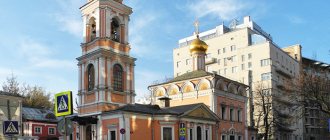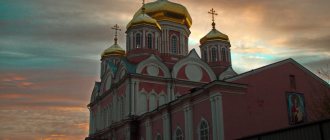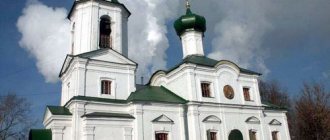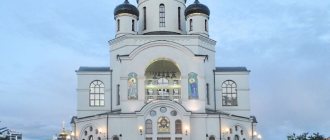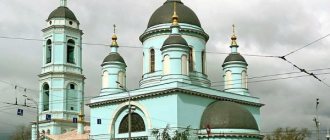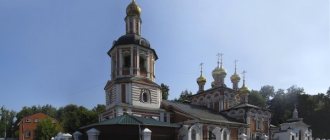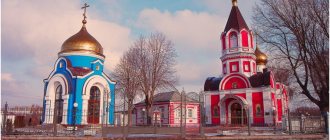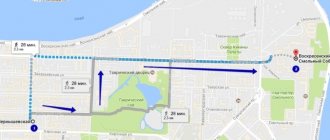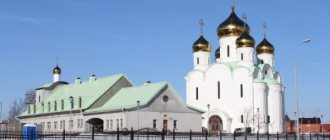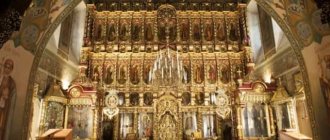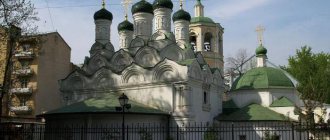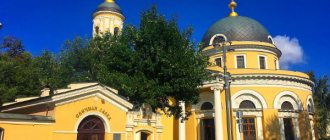Where is the Church of the Resurrection of Christ in Sokolniki
Centuries ago, Sokolniki served as a venue for royal hunting pleasures. Over time, the hunting grounds were transformed into a park, and a little later, part of the park lands was given over to industrial development. The industrial area consisted of factory buildings, factory workshops, and workers' houses. There was also a place for a hospital with a small church attached to it.
Over time, a spacious, magnificent temple was erected on the site of the hospital religious building, which is now the hallmark of the municipal capital Sokolniki. The colorful prayer building at 6 Sokolnicheskaya Square is a spectacular architectural accent of the urban environment, which is basically represented by typical multi-storey buildings.
How to get there
As if straight out of a painting, the temple attracts the attention of lovers of history and beautiful architecture, pilgrims from all over the vast fatherland. Finding the Church of the Resurrection, even for those visiting the capital for the first time, is not difficult.
Sokolnicheskaya Square, bordering the recreation park, is located 360 m from the Sokolniki metro station. A walk along the alley leading from the station to the park and temple will take 4 minutes. You can go one stop on tram 45.
At a distance of 1.4 km from the temple is the Krasnoselskaya station of the Moscow metro, 2 km away is the Komsomolskaya station, 2.1 km away is the Elektrozavodskaya station. There is ground transport from the metro towards the church.
| Metro station | Distance | Transport | Travel time |
| Sokolniki | 360 m | Walking or tram 45 | 4 min. |
| Krasnoselskaya | 1.4 km | Bus 40 | 9 stops – 9 min., then 360 m on foot – 4 min. = 13 min. |
| Komsomolskaya | 2 km | Bus 40 | 10 stops – 10 min., then 360 m on foot – 4 min. = 14 min. |
| Elektrozavodskaya | 2.1 km | Bus 332, t32 | 6 stops – 6 minutes, then 360 m on foot – 4 minutes. = 10 min. |
Story
The original small church, dedicated to the icon of the Mother of God “Joy of All Who Sorrow,” was erected at the Bakhrushin hospital, built in 1887. In 1894, priest John (secular surname Kedrov) began his ministry as rector of the church.
On his initiative, it was decided to erect a more spacious religious building, capable of accommodating all the worshipers during a large holiday gathering.
In July 1909, on the day of honoring the apostles Peter and Paul, the ceremonial laying of the church building took place. The building was built in the dominant style of those years, “Russian Art Nouveau”, according to the design of the young, gifted architect Pavel Aleksandrovich Tolstykh. The construction budget was formed by donations from Muscovites.
The construction of the temple was completed by the 300th anniversary of the Russian imperial house in 1913. The area of the Cedar Church (that’s what people began to call it) was 960 square meters. m. The largest Moscow temple of the early 20th century could accommodate up to 3 thousand believers. The main altar was dedicated to the biggest Christian holiday associated with the life feat of the Creator on earth, his Resurrection.
One chapel was dedicated to the veneration of the iconographic image of the Mother of God “Joy of All Who Sorrow,” glorified in the original church. In another chapel, a throne was placed in the name of Saints Peter and Paul, on whose triumph the construction of the religious building began. On the lower floor, a Nativity throne was installed for the sacrament of baptism.
The doors of the church were never closed to believers.
During the Soviet years, the prayer building managed to survive , despite repeated attempts by atheistically minded Soviet citizens to destroy the spiritual center.
In the 1930s there were many proposals for new uses for the church building. They planned to build a youth club, a drama theater, and an Officers' House here. However, there was a sensible official in the Moscow City Executive Committee who declared that closing the church was impossible. The argument was the fact that communities from other closed and destroyed churches found shelter in the holy building.
The Church of the Resurrection of Christ in Sokolniki adequately survived another attack - a ten-year occupation (until 1944) of the religious building by renovationists, who eventually decided to return to the bosom of the official church.
How the temple was founded
At the beginning of the century there were quite a lot of churches in Sokolniki. However, they were all small and departmental, that is, they opened under various kinds of charitable societies. There was no large temple in this area. Therefore, Father Kedrov came up with the idea of building it.
The Church of the Resurrection of Christ in Sokolniki was founded at the end of September 1908. Local boys collected money for construction. Large mugs of change were hung around their necks and they were given special certificates confirming that the funds were actually needed for the construction of the church. The consecration of the main altar of the temple took place in 1913. Other thrones (in honor of the apostles Peter and Paul, as well as the Bogolyubskaya Mother of God) were consecrated in 1915-1916.
Architectural features of the temple
The monumental two-story prayer building, with a central dome height of 34 m, is raised to the basement. The design of the temple has the shape of a cross at its base. The octagonal central volume ends with a tent with a gilded dome. Four small black domes are crowned with turrets attached to the corners of the main volume.
The raised sides of the composite cross end with zakomaras, and the lowered corner sections end with cylindrical drums with elongated bulbous heads.
The completion of 9 domes carries not only a decorative, but also a symbolic meaning. The cult building with 9 chapters conveys the image of the heavenly Church, which is based on a hierarchical division into 9 ranks of Angels and saints of God.
The Church of the Resurrection of Christ in Sokolniki is endowed with an exceptional feature. Russian churches were always built with an altar oriented to the east. The altar apse of the Church of the Cedars is directed south, towards Jerusalem, where Christ passed his life, and where the main shrine of the Christian world is located - the Holy Sepulcher. A new conceptual solution was proposed by Father John.
In the architecture of the building, Art Nouveau is intertwined with the Old Russian style , as evidenced by the tiers of pointed kokoshniks at the base of the tent and drums, perspective arched portals framing the entrances and narrow windows stretched upward.
A colorful touch is provided by the wraparound decor of bright blue glazed tiles around each reel. There are ceremonial entrances with porches on three sides of the prayer building. The gable end of each porch emphasizes the vertical direction of the building and reconciles the massive base with the elegant upper tent. The northern porch is decorated with a picturesque panel “I am the light”, the eastern entrance is decorated with “The Resurrection of Christ”.
In the western porch there is a belfry with 5 small bells.
Belfry of the Church of the Resurrection of Christ in Sokolniki
Stucco relief and carved crosses on the facades, the combination of delicate green and snow-white colors of the main surfaces with black and gold accent colors give the building extraordinary elegance and sophistication. An atmospheric element of the overall image is a beautiful ancient fence, erected at the same time as the temple.
Architecture
| Church of the Resurrection of Christ in Sokolniki.6 July 2014 |
It has an orientation that is unconventional for Russian churches, associated, according to legend, with the desire of the chairman of the construction committee, Archpriest I. Kedrov, to turn the apse to the south, towards the earthly homeland of Christ. The building is one of the most interesting religious buildings of Moscow of the Art Nouveau era, in the architecture of which the forms of the neo-Russian style received a clearly individual interpretation. The composition of the church, raised on a basement, is based on the constructive scheme of a four-pillar cross-domed church. Its central part is crowned by a slender tent-shaped octagon, along the diagonal of which there are 4 small domes. The wide sleeves of the planned cross of the temple are completed with large scalloped zakomaras, and the lowered corner cells are completed with cupolas on cylindrical drums. The nine-domed completion of the building emphasizes the expressive dynamics of the volumes growing upward, giving the silhouette of this large, monumental structure the exquisite fragility so characteristic of Art Nouveau. In front of the entrances to the church, from the north, east and west, there are ceremonial porches with gable ends (there is currently a bell tower in the western porch). The creation of the image of the temple, focused on examples of ancient Russian architecture, is facilitated by keel-shaped kokoshniks at the bases of the chapters, arched perspective portals decorating the entrances and high slit-shaped windows. The interior is a spacious, well-lit 3-nave space. In the side naves there are chapels of the icon of the Mother of God “Joy of All Who Sorrow” and Peter and Paul, in the basement there is a chapel of the Nativity of Christ. Wonderful iconostasis and floor icon cases made of bog oak are made in the spirit of eclecticism. The area adjacent to the church with a fence and clergy houses occupies a small block in front of the main entrance to the Sokolniki recreation center. In the surrounding urban environment, represented by modern multi-storey buildings, the church building is the most important architectural accent, especially impressive from the alley leading from the Sokolniki metro station to the park.
Interior decoration
The interior space of the huge, brightly lit building is divided into 3 components: a wide main nave and 2 aisles. The integrity of the solution of the central part allows you to simultaneously view the iconostasis, located in a semicircle, and the magnificent icon cases.
The two-tier carved iconostasis is made of cypress, the floor icon cases with artistic carvings in the eclectic style are made of oak.
Unlike the gilded partition with icons of the lower Church of the Nativity, the upper iconostasis is devoid of gilding. Its natural, noble color adds a strict and slightly sad note to the atmosphere.
According to legend, during the years of construction of the temple, Abbot John’s daughter died. In prayerful memory of the loss, he ordered not to decorate the iconostases and 8 small domed domes with gold. The organization of the internal temple space has its own peculiarity. The floor, as conceived by the architect, is made with a slope from the entrance to the altar, which, with a large crowd of believers, provides a good view of the sole, even for those in the last rows.
In addition to the visual effects, the acoustic component has been thought out: the vault is equipped with resonators, giving volume and strength to the sound of the choir.
In the aesthetics of elegant and seasoned Art Nouveau, white walls are not replete with picturesque paintings. Canvases depicting the evangelists decorate the sail of the main volume and the wall above the exit to the refectory. The figure of Christ is painted above the central altar.
An angel hovering above the clouds with a handwritten scroll, depicted on the entrance vault, is a reminder that the church has its own Guardian. He welcomes everyone who comes to offer prayer and writes his name in his manuscript.
The aisles are more richly decorated. Not only the apses, but also the side walls are colorfully painted. In the left aisle, attention is drawn to a painting with images of Saints Peter and Paul, in the right altar there is an image of the Virgin Mary with the Baby Jesus in her arms.
Despite the dominance of the snow-white color of the main surfaces, the interior is not silent, thanks to beautiful accent images, alternation of brightly lit and darkened interior details, and contrasting decoration made of dark noble wood. A luxurious element is the monumental chandelier, made in accordance with Byzantine artistic traditions.
Temple shrines
During the Soviet years, miraculous icons and relics dear to every Christian were brought from closing churches to the Church of the Resurrection, within whose walls divine services never ceased. A list of preserved icons and highly revered shrines of the temple has been published on the official website.
Among them, a special place is occupied by:
- a miraculous list in a continuous rich frame from the Iveron Icon of the Blessed Virgin Mary , brought to Moscow in the 17th century from the Athos Monastery and kept for about 300 years in a chapel built next to the Resurrection Gate of Kitay-Gorod;
- healing Passionate icon of the Mother of God from the 17th century. For centuries it was kept in the women's Passionate Convent, built for her by order of the first Russian Tsar from the Romanov dynasty, Mikhail Fedorovich. The monastery was abolished and destroyed by the Bolsheviks in 1937. The miraculous image was saved and preserved within the walls of the Church of the Resurrection;
- a copy of the Bogolyubskaya Icon of the Most Holy Theotokos that protects against illnesses and troubles;
- “Healer”, a copy of the ancient image of the Mother of God, kept in Georgia (endowed with the power of healing);
- a piece of payment from the Holy Sepulcher;
- a piece of the coffin of the blessed Matrona.
The church houses about 40 icon-painted faces of the Mother of God and more than 100 pieces of relics of holy martyrs and saints.
The following relics are exhibited in the temple for veneration:
- Sebastian martyrs (legendary Christian warriors);
- St. John Chrysostom;
- Saint Gregory the Theologian;
- St. Seraphim of Sarov;
- Saint Nicholas and many other holy people revered in Orthodoxy.
The Church of the Resurrection of Christ in Sokolniki is a treasury of Christian relics, one of those places in Moscow where you can touch wonderful shrines of extraordinary power.
Church of the Resurrection of Christ after the revolution
Unlike most Moscow churches, the Church of the Resurrection was not only not destroyed after the revolution, but also remained active to this day. There were frequent calls to close it - factory workers, medical staff of the local psychiatric clinic, etc. However, the Sokolniki Moscow Council never decided to deprive the believers of their last refuge in the area.
In 1945, a Local Council was held in the church (the first since 1918), at which Alexy I was elected Patriarch of the Russian Orthodox Church. 47 bishops, 87 priests and 38 laity took part in the event. Alexy I headed the Russian Orthodox Church for almost a quarter of a century until his death in 1970. Nowadays, the temple is included in the list of buildings proposed for taking under state protection in the capital.
Patronal holidays
associated with the life of the Creator on earth, and patronal church holidays are solemnly celebrated in the church
Festive services are held:
- on the birthday of Jesus - the master's twelfth feast of the Nativity of Christ - January 7;
- on the “Feast of Holidays” established in honor of the Resurrection of the Creator - Easter. The Resurrection of Christ is the central biblical event, the basis of Christian teaching. The date of the celebrations is calculated according to the calendar, which takes into account the periodicity of the movements of the Moon and the Sun. Festive services are held on the first Sunday after the full moon, which occurs no earlier than March 21, the conventional date of the spring equinox;
- on the day of honoring the image of the Mother of God “Joy of All Who Sorrow”, endowed with the miraculous power of healing from various ailments - November 6;
- on the day of glorification of the holy apostles Peter and Paul, who accepted martyrdom for their faith in Christ - July 12.
Daily life of the temple
The temple hosts daily and holiday services. For people preparing for the sacrament of marriage and baptism, preliminary educational conversations are held.
According to historical tradition, a social service society operates under the church . The foundation of the tradition was laid by the first rector, Father John, who organized a charitable aid society and educational classes for children at the workers' hospital. The social ministry of the church community is focused on helping medical institutions, sick and suffering people.
The parish provides spiritual and material assistance to the children's department of the Tuberculosis Hospital, Children's Home No. 7, and the Homeless Assistance Fund. A chapel was built on the territory of Hospital No. 14 by parishioners and clergy.
The church provides assistance to those who want to recover from addiction to alcohol and drugs. The specialized “School” employs experienced narcologists, conducts prayers for healing from illness, and provides psychological assistance to relatives of an addicted person.
The Church of the Resurrection of Christ in Sokolniki has opened a legal consultation providing free assistance on all legal issues. The largest Moscow Sunday school and youth club operate at the church.
The program for youth and adult parishioners is interesting and varied:
- pilgrimage tours to holy places;
- lectures by historians and art critics;
- poetry evenings;
- meetings with veterans;
- tea party;
- movie shows;
- music concerts;
- sport competitions.
The Church of the Resurrection of Christ has one of the best Orthodox libraries in Sokolniki, the rich collection of which is a godsend for all those interested in spiritual literature.
Moscow Goalkeeper
All beings in the highest, but also in the lower ones, without retreating, You deigned, O Mother of God, just as in ancient times Anthony was given the blessing of Mount Athos to establish the monastery of Pechersk, to bestow Your grace on the new monastery in the country of Russia, with which You blessed Athos, in the likeness of Your honorable image.
Iveron Icon of the Mother of God in the Iveron Chapel on Red Square
The image of the Iveron Icon of the Mother of God has long been considered one of the most revered in Russia. And he appeared in Rus' during the reign of Alexei Mikhailovich, when, having heard about the miraculous Iveron icon, called the Goalkeeper, the archimandrite of the Moscow Novospassky Monastery and the future Patriarch Nikon turned to Iveron with a request to donate the shrine to the Moscow kingdom. And on October 13/26, 1648, the list was delivered to Moscow.
First, the icon was in the courtyard of the Iversky Monastery, then in the Assumption Cathedral of the Kremlin and in the home church of Queen Maria Miloslavskaya. Then she accompanied Tsar Alexei Mikhailovich on a military campaign against Smolensk, which put an end to the century-long rule of the city by Lithuania and the Polish-Lithuanian Commonwealth. But the further fate of the list is not exactly known. According to one version, the icon was transferred to the Smolensk Cathedral of the Novodevichy Convent. According to another, the icon was placed on the Resurrection Gates of Kitay-Gorod, which later received the name Iveron Gates. First in a niche under a canopy, and then in a specially erected chapel. However, perhaps this was already the third copy (the second was delivered to Valdai), made in Moscow from the Athos image from the Novodevichy Convent.
Iveron Chapel
Iveron Chapel
Very soon the icon became revered. Tens of thousands of Muscovites gathered for prayer services in the chapel. It was rare that a merchant, when starting a business, did not first come to venerate the Iveron Icon of the Mother of God. And Russian emperors, starting with Paul I, considered it their duty to enter the Kremlin through the Resurrection Gate. Several more copies of the miraculous icon were made especially for the chapel. There was a substitute list, which was exhibited when the permanent image was taken for religious processions or exhibited in other churches and monasteries for solemn worship and prayer. It is possible that there were also remote copies.
In 1929, the chapel was closed by the Bolsheviks, and two years later it was destroyed so as not to interfere with the passage of military equipment during parades. One of the images was then transferred to the Sokolniki Church of the Resurrection of Christ, the other to the Tretyakov Gallery fund. It is now difficult to establish whether one of them brought from Athos is an original.
After the restoration of the Iveron Chapel in 1995, a new copy of the miraculous icon of Our Lady of the Goalkeeper kept there was sent from the Iveron Monastery on Athos. Every day, once every two hours from eight in the morning to eight in the evening, prayer services are held in the chapel with the reading of an akathist to the Most Holy Theotokos. All Moscow clergy serve in turn. This new image has already become famous for many miracles: on the chapel’s website you can read contemporary evidence of the gracious help from the Iveron Icon of the Mother of God.
Sokolniki Church of the Resurrection of Christ
Church of the Resurrection of Christ in Sokolniki
As already noted, one of the images of the Goalkeeper was transferred from the Iveron Chapel to the Sokolniki Church of the Resurrection of Christ - it was one of the few that did not close after the revolution. Thanks to this, many shrines came here from closed and destroyed temples and chapels. In addition, a noteworthy fact is associated with the iconostasis of the temple. To the left of the royal doors, where the icon of the Mother of God, most revered in a given temple or in a given area, was usually placed, we see an image of the Iveron Icon. Moreover, the iconostasis was completed in 1913, that is, 16 years before the miraculous Iverskaya of Moscow chose this temple for her stay.
After praying in front of the icon, the mother found her son, who had disappeared several months ago: she left the temple and... saw him
The Iveron icon is placed in a rich robe and decorated with voluntary donations from people who received healing. And at the bottom of the icon in the “eye” there is a particle of the shroud from the Holy Sepulcher. Every week prayers and akathists for the miraculous icon are served in the church. And the Mother of God soon responds to the requests of those praying.
As the temple employees say, miracles happen here all the time. Many couples, including many celebrities, were able to give birth to a long-awaited child after ten years of marriage. After praying in front of the holy image, the mother found her son, who had disappeared several months ago: she left the temple and saw him in the crowd in front of the park. Although before that they searched with the police, and all to no avail. Quite a lot of healing occurs; according to the testimony of relatives and friends, even from a coma the Blessed Virgin brings us unharmed. He doesn’t refuse to do the little things either – for example, looking for a missing earring. And it appears to everyone in their own way.
The image in the golden robe has darkened with time, but believers see facial features, curls, and even the movement of clothing, as was the case with the cameraman of the film crew who came to shoot a film about the Iveron Icon of the Mother of God.
Church-Museum of St. Nicholas in Tolmachi
Church-Museum of St. Nicholas in Tolmachi
This temple was occupied by the services of the Tretyakov Gallery until the 1990s. Worship services resumed only in 1993. Now during liturgical hours the temple is open to all believers, and during other hours it functions as one of the halls of the Tretyakov Gallery dedicated to religious art. It was here that the Iveron Icon of the Mother of God, which had been kept in storage for a long time, was transferred. After careful examination by gallery staff, it turned out that the painting corresponds to the second half of the 17th century. In addition, the icon was portable and revered. This is evidenced by the removal devices and the coins preserved below the runner. The icon was cleared, but left practically without restoration, so that people could see that it was an ancient prayer image.
Temple of the Iveron Icon of the Mother of God on Vspolye
Temple of the Iveron Icon of the Mother of God on Vspolye
In 1792, from the replacement list of the Iveron Chapel, another list was made for the newly rebuilt church in honor of the Iveron Icon of the Mother of God on Vspolye. For ten years this image remained in the chapel, and then was transferred to the temple, where it remained until its closure in 1929. Then, in order to save the miraculous image from destruction, the parish gave it for safekeeping to the Church of St. Nicholas in Kuznetsy. It remains there to this day, since the ancient icon requires special conditions of maintenance, and restoration in the Iversky Church has not yet been completed.
On the eve of the opening of the temple, the colors of the image again became light, and the frame became silver
Now there are three images of the Iveron Icon in the temple. The first one after the opening was brought by the rector, Archpriest Gregory Ivanusa. This was the image of the Goalkeeper, with which the old nun Taisiya blessed him in his youth and predicted that he would become the rector of the temple in honor of this icon. Until then, the ancient icon, darkened by time, was kept in the priest’s house, but on the eve of the opening of the temple, its colors became light again, and the frame became silver. And this is not the only miracle associated with the Iveron Icon.
According to Father Gregory, in the winter of the first year the heating was turned off in the church for non-payment: they did not keep track due to inexperience, and the debt amounted to 12.5 million rubles. It was difficult to serve, but along with trouble came help. The required amount was donated by a friend of the owner of a hunting store, who placed a “box” for donations to the church in honor of the Iveron Icon. There were also candles and notes with the name of the temple. A friend also started her own business, but it didn’t take off. Tired of the troubles, she came to ask her friend for help. And only in the store, when I saw the name of the temple on the notes, I remembered one event. A few months before, she dreamed of an unusually beautiful Woman in a blue robe, who told her to donate the necessary amount to the temple in honor of the Iveron Icon of the Mother of God. “We are like the Apostle Thomas. Do you believe? I believe, but you have to put your fingers in.”
Now prayers and akathists are served at the icon. Decorations appeared in the frame behind the glass - evidence of the miraculous help of the Lady: someone received healing, someone received a long-awaited child.
In addition to this, there are two more Iveron icons in the temple: an ancient image, painted by an unknown monk in 1912, is in the altar, and a life-size one in the center of the temple - a gift from the publishing house. Perhaps, over time, the first list from the Church of St. Nicholas in Kuznetsy will return.
Novodevichy Convent
Novodevichy Convent
After the abolition of the Novodevichy Convent in 1922, the Goalkeeper, along with other relics and valuables of the monastery sacristy, was kept in the funds of a branch of the State Historical Museum organized within the walls of the monastery. In 2008–2010, the icon was transferred several times to the revived monastery for veneration, and in 2012 it was finally returned. The shrine was moved to the Assumption Cathedral, since the historical location of the Iveron Icon of the Mother of God, the Smolensk Cathedral, is open to visitors only in the summer.
Opening hours and schedule of services
There is a specific time allotted for visiting the temple:
- Monday to Saturday from 7:30 am to 7:00 pm;
- on Sunday from 6:30 am to 7:00 pm.
Morning prayer hours:
- on weekdays at 8:00 a.m. liturgy is held;
- on Sundays and holidays there is an early liturgy at 6:45; at 9:30 - late liturgy.
Evening service begins at 17:00:
- from Monday to Friday, believers gather for Vespers and Matins;
- On Saturdays and on the eve of holidays, all-night prayers are held.
Interesting facts about the Church of the Resurrection of Christ in Sokolniki
The name of the creator and the history of the founding of the religious building are overgrown with legends:
- Archpriest John, who was shot during the years of repression and canonized, did not immediately initiate the construction of a grandiose temple. For a long time he had doubts about the rationality of building a large temple in an industrial area, fearing that the funds of the poor people would not be enough to complete the good deed.
- A legend is passed down from mouth to mouth that the Mother of God appeared to John in a dream and ordered the construction of a new beautiful church, the ringing of which would remind people of spirituality, repentance and humility. Father John saved the money of his flock, but did not dare to start construction. The Mother of God once again came to him in a vision. Her face was powerful and stern, and, fearing disobedience, the priest began to work, trusting in the Will of the Lord.
- However, there was not enough money to carry out all the work. By Divine guidance at this time, one Moscow merchant made a vow to donate funds to the temple and asked the Creator to indicate it. In a dream vision, Saints Peter and Paul appeared before him and told him about the church being built. The merchant found a prayer building and contributed a significant amount to pay the construction team.
- Then a pilgrim came to Abbot John with a request to shelter him for one night. The priest fed him and placed him in a cell next to the church for the night. In the morning, the wanderer left unnoticed, and left money on the table in the room - exactly as much as was needed to complete the temple.
The story of creation is an example of Divine assistance to good undertakings, confirmation that miraculous events could occur not only in the times of the Old Testament, but can also happen in modern reality.
A visit to the Church of the Resurrection of Christ, located in Sokolniki, leaves a deep, incomparable emotional impression.
In a beautiful building with a bright atmosphere, in front of miraculous shrines, the vain stream of consciousness is suspended, purification and inner rethinking of the world takes place.
Article design: Svetlana Ovsyanikova
About the temple
- Clergy
- Shrines of the Temple
- Chronicle
ENGLISH
The Church of the Resurrection of Christ in Sokolniki was built in 1909-1913. designed by the architect P. Tolstykh. On September 28, 1908, the foundation stone of the temple took place by His Eminence, Metropolitan of Moscow and Kolomna Vladimir, who was killed in Kyiv in 1917. And five years later, the majestic temple was completed and consecrated on December 22, 1913 by His Eminence Macarius, Metropolitan of Moscow and Kolomna.
The temple is an outstanding example of church construction in the Russian Art Nouveau style. The initiator of the construction was Moscow Archpriest John Kedrov, who became its first rector.
Before the construction of the temple, Father John was the rector of a small hospital church in honor of the icon of the Mother of God “Joy of All Who Sorrow” at the old Ostroumovskaya hospital in Sokolnicheskaya Sloboda. At that time (late 19th - early 20th centuries) Sokolniki was a working-class area where mostly poor people lived. Father John spared no effort to help his flock both spiritually and financially. But he constantly felt the inadequacy of the assistance provided: people were overwhelmed by worries about their “daily bread”, rarely visited church, and the small hospital church could not accommodate everyone who wanted to pray, especially on holidays. And so, as if in response to Father John’s tireless prayers for his flock, the Queen of Heaven herself appeared to him in a dream vision and ordered the construction of a beautiful, spacious church in Sokolnicheskaya Sloboda, so that it could be seen from afar, and the ringing from its bell tower could remind the surrounding residents about repentance and the need for spiritual life. Waking up, Father John was extremely embarrassed by this vision, because he did not have money to build a church: a small hospital church, and located in a poor area, did not generate enough income. And so Father John, day after day, month after month, keeps postponing the construction, still he does not dare to start it. And then his vision was repeated for the second time, but now he saw the Mother of God with a stern and imperious face. Afraid of being disobedient and relying on the Will of God, Father John begins construction, without even thinking about how he will pay.
And now the external work was almost completed, the deadline for settlement with the builders was approaching, and despite the donations of the parishioners, there was still not enough money. Father John fervently prayed to the Lord and the Mother of God, and help was not slow to appear.
Tradition says that there was a wealthy merchant in Moscow who, through a vow, decided to donate a significant amount to the temple of God. He prayed that the Lord would show him the temple that was most in need of such help at this time. Sts appeared in a dream. App. Peter and Pavel spoke about the construction of a majestic temple in Sokolnicheskaya Sloboda. Waking up the next morning, the donor immediately went to Sokolniki, found a newly built church and presented his donation to Father John. Tradition says that the donated amount was just enough to pay the workers.
Financial difficulties did not leave Father John throughout the entire construction. When the temple was already completed and ready for consecration, the deadline for final settlement with the workers came, and again there were not enough funds. And the night before, a certain old pilgrim came to Father John and asked for shelter. Father John placed him in one of the annex cells of the newly erected temple, fed him and spent the entire evening talking with this pilgrim. When the next morning Father John came to the elder, the cell assigned to him the day before turned out to be empty, and on the table lay money, a significant donation for the construction of the temple. Father John knew almost nothing about his guest, he only remembered his name - Nikolai. Seeing such an obvious miracle, God’s help, Father John thanked God and His Saint Nicholas for supporting the undertaking. Since then, St. Nicholas the Wonderworker has been one of the most revered saints of the temple.
And so the temple was erected. The majestic (with an area of 960 sq.m.) and high (the height of the main dome is 34 m, the side aisles are 22 m) two-story nine-domed temple has the shape of a cross. Every detail in the temple has not only its practical, but also spiritual, symbolic meaning. Thus, 9 domes have long been erected in Rus' in honor of the 9 Orders of Angels, serving and praying before the Throne of God. The newly erected temple also had its own peculiarity. All Orthodox churches were built invariably with the altar facing east. The newly erected Church of the Resurrection of Christ, in Sokolniki, faces the altar to the south, towards the Holy Sepulcher in Jerusalem (Jerusalem Church of the Resurrection of Christ).
The temple has, in addition to the main altar, consecrated in honor of the Resurrection of Christ, two chapels. The right aisle of the temple was consecrated in honor of the icon of the Mother of God “Joy of All Who Sorrow” (in memory of the hospital church in which Father John Kedrov began to serve), the left - in the name of the supreme apostles Peter and Paul (in memory of their help in the construction of the temple ). The lower church was consecrated in honor of the Nativity of Christ. Currently, the sacrament of baptism is performed here.
The carved iconostases were made from cypress according to the design of the architect P. Tolstoy. Subsequently, artistically carved oak icon cases were made for the icons, and majestic chandeliers were made in the Byzantine style. Unlike the gilded iconostasis of the lower church, the main iconostasis retained the natural dark color of cypress. We are accustomed to seeing gilded iconostases of Orthodox churches, so the interior decoration of the temple is perceived as austere, even a little sad. There is a legend told by the oldest parishioners that during the construction of the temple, Father John Kedrov suffered a misfortune: his daughter died. And so, in prayerful memory of this mournful event, he ordered not to gild the iconostases and 8 domes of the temple.
According to ancient Orthodox tradition, the Church of the Resurrection of Christ has a high porch. Any Orthodox church has a porch. This is not only the entrance into the temple, but also the ascent, the path to heaven, the path to God. Pious Christians came to the temple long before the start of the service and, going up to the porch, at each step they said the publican’s prayer: “God, have mercy on me, a sinner.” Thus, by humbling himself, a person sought to ascend, draw closer to God, and become a worthy witness and prayerful participant in the greatest Christian sacrament - the liturgy.
Even during the difficult 20th century for Russia and the Russian Orthodox Church, the Church of the Resurrection of Christ in Sokolniki did not close. Its doors were always open to parishioners, and services within these walls never ceased. Therefore, from many closed churches and chapels, miraculous icons and other shrines dear to the heart of the Orthodox Muscovite were brought here.
The main such shrine is the Iveron Icon of the Mother of God - a copy of the miraculous Iveron Icon - “Goalkeeper”, which is located on Athos. By order of Metropolitan Nikon of Novgorod, later His Holiness the Patriarch, a copy of it was made in the Iveron Monastery on Mount Athos. In 1648 he was delivered to Moscow. The icon was solemnly greeted by the Tsar and Patriarch at the Resurrection Gate. Later, a special chapel was built on this site, in which the icon was placed. The Moscow Iverskaya became famous for its miracles and became one of the most revered icons in Russia. Since 1669, it was located in the Iveron Chapel at the Resurrection Gate near the Moscow Kremlin. In the most crucial days of the Russian state, during the days of wars and national disasters, nationwide prayer services were held before the Iveron Icon, attracting tens of thousands of Muscovites. Prayer services at this holy place were an obligatory part of ceremonies during visits to Moscow by Russian tsars and emperors. All Russian emperors, starting with Paul I, considered it their duty to enter the Kremlin through the Resurrection Gate. Emperor Nicholas II, arriving in Moscow, first of all came to the Iveron Chapel to venerate the miraculous icon.
In 1929, after the destruction of the chapel, the icon was moved to the Church of the Resurrection of Christ in Skolniki. It is interesting to note one detail. The iconostasis of the main altar was completed in 1913. To the left of the Royal Doors, where the icon of the Mother of God, most revered in a given temple or in a given area, has long been placed, in the Church of the Resurrection of Christ in Sokolniki we see an image of the Iveron Icon, beloved and revered by Muscovites. But, as we have already noted, the iconostasis was completed in 1913, i.e. 16 years before the miraculous Iverskaya of Moscow chose this temple for her stay.
The Iveron icon is placed in a rich robe and decorated with voluntary donations from people who received healing. At the bottom of the icon we see another shrine placed here. In the “eye” there is a piece of shroud from the Holy Sepulcher.
The temple also contains other great shrines: the icon of the Holy Mother of God from the Passion Monastery, the substitute icon (list 1918) of the Bogolyubskaya Mother of God from the Barbarian Gate of China-Gorod, the icon of St. Panteleimon from the Panteleimon Athonite Chapel at the Lubyansky Gate of China-Gorod.
The church hosts public talks and daily divine services. There is a baptistery for adult baptisms. There is a Sunday school and a parish library, and the newspaper “Parish Bulletin” is published.
